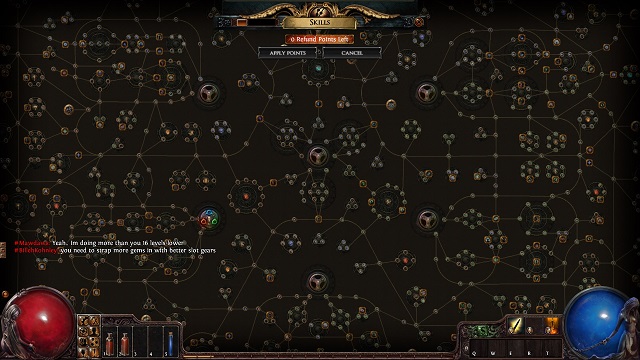Passive skills | Characters and their advancement Path of Exile Guide
Last update: 11 May 2016

In Path of Exile there are two types of skills - passive and active (that require being used). First, let's have a look at the former category, which is directly linked with increasing the characters' attributes. The monstrous skill tree represents all passive skills in the game. They're shown as nodes of various types and sizes. There are three types of these nodes:
Small nodes that make playing a bit easier by slightly increasing our abilities, for example max health or axe damage.
Pathway nodes add 10 points to a specific attribute and serve as a pathway to desired passives.
Big nodes are an improved type of the first category that gives us major bonuses in either percentage or points (not only increasing the stats).
All nodes are connected to a certain attribute so when you choose the strengths of your character, you should unlock only the ones we need. This strategy ensures an effective development based on abilities. When you create your character, you should take a closer look at all the tree and decide which big nodes you want to unlock, then which of the small ones are connected to these skills and finally plan a development path through the pathway nodes. Big amounts of points invested in specific attributes let us use more powerful items and skill gems that are described in the next subchapter. Speaking of items, many passive skills are about using specific types of weapons. So if your inventory consists of bow and arrows, you should increase your accuracy and damage dealt with bow. A warrior specialized in melee combat - for example with clubs - should focus on stunning the enemies and critical hits.
When you pick the weapon you want to use, choose around 7 big nodes connected to it and affecting other useful character attributes. Obviously, initial choices are just a beginning of a long and very enjoyable character development. You can change it to match the current gameplay later on. You can either act spontaneously or plan everything. Beginners should unlock only the nearest nodes because going farther into the tree might cause a lot of problems.
The next step is to choose a path to selected nodes. It will often have more of the big ones that you didn't choose but can be useful. In this case it's up to you if you decide that, for example, defense against elements is useful or useless. You should however avoid skills that are completely useless for your character. The easiest way to get to the desired nodes is along the pathway ones but it has many disadvantages. Firstly, unlocking small nodes gives you more than the pathway ones. Secondly, if you only use pathway nodes, you may end up with a huge amount of points in attributes, which isn't very useful. Remember that you also improve stats with items in your inventory, so you should distribute your points wisely.
Additional information
Each character can unlock only 120 nodes in the tree. What's important, you can't skip any nodes in favor of other. A connection must be kept. It's not easy considering the size of the tree and precision with which it was created, so beginners should see the chapter with example characters first.
